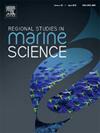Regional environment influences the population genetic structure and diversity of the barnacle Fistulobalanus albicostatus
IF 2.1
4区 环境科学与生态学
Q3 ECOLOGY
引用次数: 0
Abstract
Population differentiation (population genetics) among oceanic species is influenced by both global and regional environmental factors. In this study, we aimed to determine the effects of regional environmental pressures on the genetic diversity of sessile invertebrates by assessing the genetic structure of the barnacle Fistulobalanus albicostatus collected from nine sites in South Korea between February and May 2023, based on nucleotide variations in the mitochondrial DNA cytochrome c oxidase subunit I (COI) gene. Our analyses included assessments of extensive haplotype diversity (h), limited nucleotide diversity (π), neutrality tests with Tajima’s D and Fu’s Fs, mismatch distribution, population differentiation (Fst), non-metric multidimensional scaling (nMDS), and COI haplotype networks. Based on 174 (602 bp) sequences obtained from the nine populations, 89 polymorphic sites and 106 haplotypes were identified. Most haplotypes were specific to each population, whereas certain major haplotypes were predominant in the Busan and Gunsan populations (23.1 % and 15.8 %, respectively). These findings suggest that regional environmental factors, such as restricted larval dispersal due to ocean currents and salinity fluctuations from human-made structures, affect genetic diversity. Additionally, the unimodal distribution observed in the Yeosu population likely reflects its large population size, relative to a smaller sample size. This study highlights the influence of the interaction of life-history traits of marine organisms with local environmental factors on population structure and the importance of appropriate sample sizes in population genetics studies.
求助全文
约1分钟内获得全文
求助全文
来源期刊

Regional Studies in Marine Science
Agricultural and Biological Sciences-Ecology, Evolution, Behavior and Systematics
CiteScore
3.90
自引率
4.80%
发文量
336
审稿时长
69 days
期刊介绍:
REGIONAL STUDIES IN MARINE SCIENCE will publish scientifically sound papers on regional aspects of maritime and marine resources in estuaries, coastal zones, continental shelf, the seas and oceans.
 求助内容:
求助内容: 应助结果提醒方式:
应助结果提醒方式:


